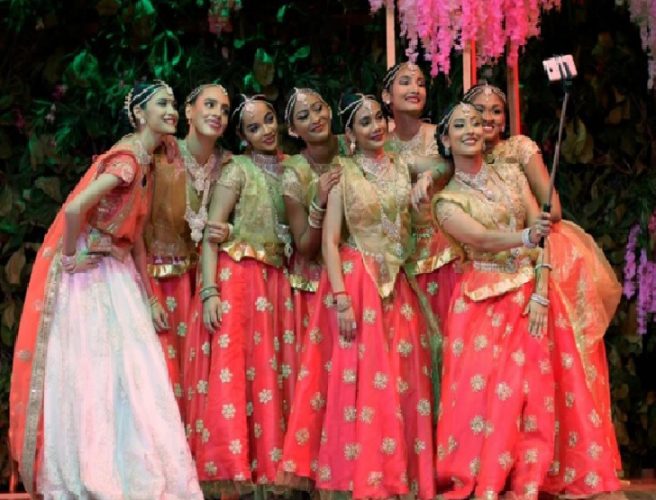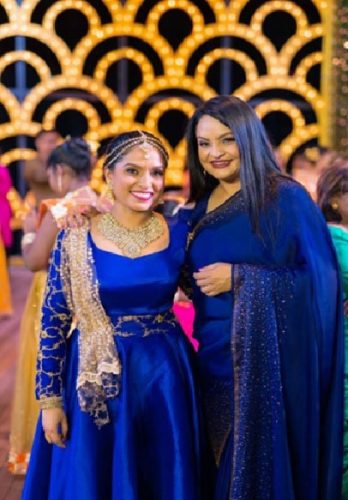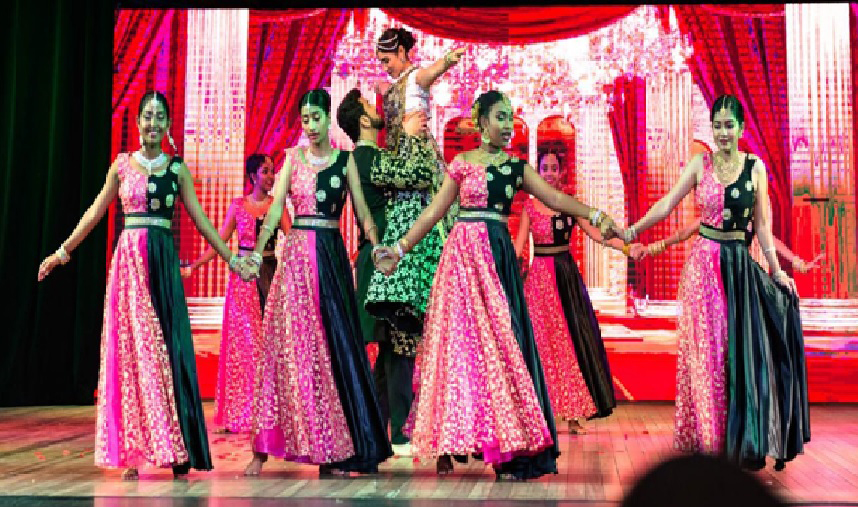Naya Zamana 23 returned to the National Cultural Centre last weekend with the performance of the dance drama Zindagi Express directed and choreographed by Dr Vindhya Persaud. It was a repeat appearance of this production that had already made a strong statement in both theme and theatre – social significance, style, form and technical stage quality.
Naya Zamana is the annual production of the dance and performance group Nritya Sangh from the Dharmic Sanskritic Kendra of the Guyana Hindu Dharmic Sabha. Zindagi Express exhibited the current state and achievements of Naya Zamana and of the Nritya Sangh, a major dance company in Guyana that has advanced from variety shows to full dance productions and now full-length dance dramas.
 There were no surprises and less of an impact because the production was seen already. But this repeat was likely by popular demand, because there was a full house once again; the show was completely sold out when it was first done last year. But the second-time-around experience was more meaningful and left a deeper impression arising as one was able to see things that might have been missed before.
There were no surprises and less of an impact because the production was seen already. But this repeat was likely by popular demand, because there was a full house once again; the show was completely sold out when it was first done last year. But the second-time-around experience was more meaningful and left a deeper impression arising as one was able to see things that might have been missed before.
There was surely an advancement in dance drama on the Guyanese stage. Full dance productions on the one hand, and plays on the other, are established and well known, and the National Dance Company includes dramatic plots in many long pieces, but a full dance drama is still uncommon. Additionally, in Zindagi Express there was emphasis on spectacle, colour, and scenic backdrops. It was rich in costuming, music, lighting, sound, dance, pathos and humour. These are some of the factors characteristic of Bollywood, and of Indian dance theatre, but used to effect in this production.

The work of Trishala Persaud was monumental. She was responsible for much of the spectacle produced by intricate and detailed costuming, as well as the set, consisting of several changing scenic backdrops, often flown in with startling colour effects which vividly supported the action in an overall set design that was minimalist.
This advancement went further when the statement made by the drama, the themes and the lessons are added. Vindhya Persaud presented a drama against social ills and in promotion of enabling human qualities that can sustain individual independence, confidence and empowerment. This plot promoted fortitude, perseverance, resolution and independence, qualities that can result in triumph. It was about the strength of women against a hostile social environment.
The tale was told of three girls who were victims in different ways but emerged triumphant in the end. However, their victory did not come at the wave of a fairy’s magic wand. The characters learned. They grew as the drama progressed and emerged at the end, not just triumphant, but as better people.
Farzaana Khan played Misha, who was a resounding success as a stage performer, winning awards and public acclaim, but privately, was unhappy, unsure of herself and oppressed. Her engagement to Veer, played by Darsh Mody, was suffering since she was the victim of abuse, both emotional and physical. She endured it because of her notion of being in love with him. As the drama developed, she learned through a combination of experience, the positive influence of others and growing self awareness, that she did not have to accept such treatment and eventually rejected it, ended the engagement and cancelled the planned wedding. This is a common tale in society as some women endure domestic violence and are unable or unwilling to leave. This drama is thus instructive.
Khan was convincing in her role which she negotiated sensitively, able to capture the necessary emotions. Opposite her, Mody held his own, but was a bit flat, not managing the extremes of anger and petulant rage necessary to evoke the intended pathos.
Sarah Dhanraj played Piya, who had enviable academic ability but was constantly oppressed and bullied by her classmate Tina (Aliyah Hassan) and her gang. Interestingly, the tyranny was not only harmful pranks and pushing around, but included cyber bullying, an offence very prevalent in this modern technological age, but one of which most people are not aware. Physical bullying is currently a real danger in schools, sometimes resulting in violence, death, suicide or psychological damage. In this case, it was obviously responsible for Piya’s low self-esteem and unhappiness, which Dhanraj did very well as an actress to portray.
Like Misha, Piya was able to mobilise the courage to refuse to continue as a victim and confront the problem. The resulting resolution was a bit dramatically sudden, and the reformation of the bully Tina somewhat unconvincing, but the statement was made effectively enough about the confidence to stand up against these offences, which can even have positive influence over the offender.
Anusha Doodnauth played Avni, who struggled to succeed as a professional events planner against a society unwilling to believe in her ability as a young woman. She came up against a variety of prejudices and superficial judgments. She withstood the pressures exerted by the mounting odds against her including the mounting tides of bills to pay overpowering insufficient income. Her main asset was an unwavering belief in herself, her abilities and her will to succeed. She never gave up thinking that her business would survive and her strength, insistence on independence and perseverance sustained her. These were complemented by the loyalty and support of her assistant Anaya (Amisha Sarjoo). Eventually, the whole world collapsed around her, and not a moment too soon, help arrived to rescue her from the debris.
Yet, as in the case of Misha and Piya, this salvation did not come from a fairy godmother, but as a consequence of her own hard, unwavering work and capabilities. It was because she managed to impress those for whom she had worked, including the conceited young business executive and workaholic Naman, played in a too-subdued fashion by Travez Piaralal. His was another case of positive influences as both Avni and Naman had a good influence upon each other. Working closely with her, he was moved to overcome his prejudice, arrogance, addiction to work and a slight case of patriarchal misogyny.
Another factor in the resolution was the ever-present friend, Arnav, the funny guy, the clown/comic, a stock character type always found in Bollywood films. But he was here in this drama as a pillar against which one could lean – an encouragement. Deepta Banik played him very well. It was comic relief, but the good nature of a friend who was, ironically, not willing to put up with those bad attitudes and offensive behaviours that needed to be eradicated. What made Banik more of an asset was his ability to dance.
The audience could draw much instruction from those statements. But Zindagi Express was also a lesson in technical theatre. The production was technically excellent in the way it delivered light and sound, and where these were concerned, it was the best seen at the National Cultural Centre (NCC). Persaud brought in extra reinforcement and embellishment to produce what might not have been possible if the normal NCC equipment were depended upon. Travellers, a professional commercial company, provided lights, while the NCC sound was assisted by Varun Samlall.
These enhanced the outstanding qualities of the production, characterized by spectacle, set, costuming and music. Music drove dance, which was sometimes electrifying, sometimes moving. The best dances blended with the themes and statements.
The impressive “Ghar More Padesi” was one of these and it gave power to the opening of Act 2 after intermission, with very interesting music. This started with a chant from the Ramayan, that great classical work sacred to Hinduism, which tells the story of Lord Ram (Rama), an exemplary king and a demonstration of the holiest principles of Hinduism and recommendations to mankind.
The choreographer embellished the dance with symbolism and several pieces of moving imagery in an elaborate choreography. Some of the images were indeed reflective of the Ramayan. The dance was visually stunning, emotionally deep and spiritually meaningful.
Another was the final dance before the end, which finally reinforced the triumph of the women and the resolution of the plot. Symbolically, dancers assumed battle positions and brandished weapons of war. There was a blend of three pieces of music which gave glory to god in female and male forms. The first “prayer” in that music was described as speaking about “the enemy as ignorance” and destruction of that “with wisdom and knowledge”. These speak directly to the plot and statement in the drama as “a powerful prayer for women”. It is very meaningful, underlining the triumph of the three girls, also bringing a triumphant end to the performance itself and signifying a theatre of belief and faith.
Zindagi Express had a very large cast of dancers and actors and a style and structure built much around dances and not very much capacity for full, sustained acting. The principals did have enough space to be effective and to carry the plot. The production, though, made demands on scene transitions, which Persaud handled competently as director and stage manager. There was able assistance from the stage crew led by Tiffany Bissesar with Amisha Arjune and Jaspal Mohabir.
This repeat of Naya Zamana 23 made use of some of the best characteristics of Indian dance theatre (or cinema). It was an experience in theatre and an experience in humanity. Here was a tale of women who triumphed, dramatised in triumphant theatre.

